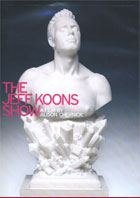
The Jeff Koons Show 2004
Distributed by Microcinema International/Microcinema DVD, 1636 Bush St., Suite #2, SF, CA 94109; 415-447-9750
Produced by Voyeur Films Inc
Directed by Alison Chernick
DVD, color, 65 min.
College - Adult
Art History, Biography, Popular Culture, Business
Date Entered: 09/20/2010
Reviewed by Barbara J. Walter, Longmont Public Library, Longmont, COJeff Koons never fails to elicit strong opinion, positive and negative, with his work. Is it deceptively simple or simply vacuous? Shatteringly soul-baring or pornographic? Is he one of the most influential artists of the 21st century (Esquire, 2008) or the king of kitsch? Despite—or perhaps because of—the controversy surrounding his art, Koons is one of America’s most commercially successful living artists.
The Jeff Koons Show plots the arc of this neo-pop artist’s career, from staffing MoMA’s membership desk to commanding millions for his sculptures at Christie’s Auction House. Director Alison Chernick draws on extensive interviews with Koons, art critics, curators, and fellow artists to craft a rather congratulatory portrait of the artist, his vision and body of work. At the same time she infers that ambition, astute self-promotion and financial savvy are what actually propel Koons to the ranks of the artistic elite.
The “show” opens with footage of construction of one of his most popular works, the 43-foot-tall live-flower-bedecked sculpture “Puppy.” Cut to Koons, smiling and soft-spoken, earnestly proclaiming himself the end of the 20th century in art, rivaling Picasso and Duchamp. We observe his earliest exhibitions (entirely self-funded through his day job as a commodities broker) featuring pristine Hoover vacuums encased in clear boxes, Spalding basketballs suspended in fluid-filled vitrines. While other interviewees elaborate on the significance of these works, the artist states plainly why he chose to use ready-made products—whenever a viewer sees a basketball or a vacuum cleaner, Koons’ artwork immediately springs to mind.
Probably the most important exhibition at the end of the 20th century—according to the artist—his “Banality” show is deliberately awash in gaudy sentimentality and bad taste, through which he hopes to exorcise the guilt and shame we feel when enjoying kitschy art. Koons’ work takes an extremely personal turn with his “Made in Heaven” exhibition, depicting graphic sex between the artist and then-wife Ilona Staller, a former pornographic film star, in an amazing variety of media. Most poignant is his “Celebrations” collection, and particularly the huge, perfectly polished and brightly tinted steel sculpture “Balloon Dog,” which express his longing for his son Ludwig (Koons and Staller divorced in 1994, then Staller moved to Italy with their two-year-old). While it may be difficult to decipher what Koons is attempting to convey through his work (and his comments throughout the film only add to the puzzle), The Jeff Koons Show leaves no doubt in the viewer’s mind that this man has a clear understanding of the role salesmanship plays in a successful career in the arts.
This is a well-crafted, insightful portrait of a controversial contemporary artist, suitable for use in college-level art survey courses, appropriate for academic libraries and larger public libraries collecting extensively in visual arts.